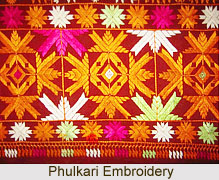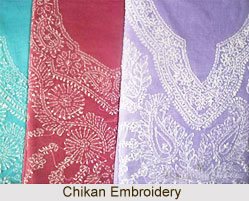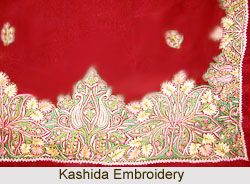Embroidery is an age old tradition prevailing in India since ancient times. Over time, this art has hugely evolved to form a variety of stitches and artworks. Exclusive decoration of fabrics with multicoloured threads, metals, mirrors, beads, stones etc is the essence of this art. Embroidery work has spread in different regions of the country and several regions have developed their unique style of embroideries that gradually became one of the identifying features of their cultural heritage. Embroidery in Northern India has also emerged as prominent artworks of India. A number of beautiful stitches like cross stitch, satin stitch, chain stitch, running stitch etc are used to make attractive patterns.
 Embroidery in Punjab
Embroidery in Punjab
Embroidery is enlisted among the traditional arts of Punjab as a prominent and beautiful art. Different region of the state are known for their exquisite artefacts having embroidery work. Phulkari embroidery is the most renowned embroidery of Punjab which is used in a variety of artefacts including cardigans, table covers, scarves, bedspreads, cushion etc. Fabrics are decorated with threads of vibrant colours and intricate designs. Floral motifs are the most common patterns found dominantly on all traditional attires. Historical facts suggest that the art is about 2000 years old and the Vedas also have the mention of this art. In ancient times, `odhnis` adorned with Phulkari embroidery were highly popular crafts of this state. Another common motif made in Phulkari embroidery is barley and wheat stalks which grow all over the state. Crochet embroidery, also known as Chetipani, is also a famous embroidery practiced in Punjab. Athakupani refers to the embroidery work where different flower designs are joined to form beautiful patterns. Embroidery of Punjab has gained huge recognition throughout the country.
Embroidery in Haryana
Phulkari embroidery is also prevalent in Haryana which is being practiced since a long time. It is mostly practiced by the folk women of the state. Spectacular motifs of flowers, human figures, birds etc are made and the whole fabric is covered with intricate embroideries. The carpets are generally embellished with geometrical patterns. The main centre of Phulkari embroidery in Haryana is Panipat. Combination of colourful threads and diverse motifs in this art is its most alluring feature which displays the creativity of the artisans of Haryana at its best.
 Embroidery in Uttar Pradesh
Embroidery in Uttar Pradesh
Uttar Pradesh has, since ages, patronized the art of embroidery and different forms of this art have evolved in this state. The most prominent embroidery in Uttar Pradesh is Chikan embroidery. Originated in Lucknow, this type of embroidery involved a number of patterns and stitches to form beautiful decorative motifs. Creepers are the most common motif whereas other motifs are also made with threads of vibrant colours. Different types of stitches are used to render different appearances like darn stitch, satin stitch etc. Embroidery is a traditional art of the state and around 40 stitches have been recognized, out of which 30 are still in practice. Fine craftsmanship of artisans is expressed beautifully through the chikan embroideries. This art has acquired a prominent position in the world market also owing to the appealing look it bestows on the fabric.
Embroidery in Himachal Pradesh
Embroidery in Himachal Pradesh is broadly classified into two categories viz. leather embroidery and rumal embroidery. Embroidery work is mostly carried out by the local women of the state. The most common artefacts of rumal embroidery include scarves, hand fans, prayer gloves, caps etc. Themes of these embroideries hover around majestic landscapes of the state, Ramayana, Mahabharata and Raslila of Radha and Krishna. Threads of dazzling colours are used for making attractive motifs on light coloured fabrics. Exquisite embroideries on leather artefacts is also another popular item of Himachal Pradesh that flourished greatly under royal patronage. Suni embroidery is also practiced widely and includes mainly geometrical patterns. These embroideries are the traditional arts of Himachal Pradesh which have earned great acclamations through the work of deft artists.
 Embroidery in Jammu and Kashmir
Embroidery in Jammu and Kashmir
Jammu and Kashmir is highly famed for beautiful embroidery works. Embroidery of this state is also well known in the international market. Richness and beauty of these embroideries are its two most alluring features. Kashida embroidery is a famous art that includes a variety of stitches like sujni stitch, zalakdosi stitch and buttonhole stitch. It is used to adorn a number of artefacts like shawls, rugs, cloaks etc. Amli embroidery is also used in shawls to make unique motifs with multicoloured threads whereas Do-rookha is another embroidery used to create double sided patterns of vivid hues. Gold and silver embroidery is used to embellish the necks of phirans and gowns. Floral and geometrical motifs are made on floor mats and decorative pieces with chain stitch, cross-filling stitches or appliqu‚s. Pashmina shawls are the most popular artefact of Jammu and Kashmir that exhibit gorgeous patterns and colours.
Embroidery in Rajasthan
Rajasthan has an age old tradition of embroidery work and the craftsmanship of this region has added a new essence to this art. The prominent embroidery in Rajasthan includes gota work, metal embroidery and suf bharat. A variety of artefacts are decorated with beautiful embroidery of Rajasthan such as bedspreads, wall hangings, garments, shoes, animal trappings etc. Embroidery with intricate patterns with multicoloured threads renders an attractive look to the items. Metals, beads and stones are often sewn to the fabrics with different stitches. Zari embroidery that comprises of metallic threads is also quite common in this region and furnishes a gaudy and appealing look. Zari works on curtains, velvet coverings, temple chariot coverings and wall hangings are very popular in Rajasthan. This traditional art is mostly practiced by women belonging to tribal or folk communities. The artefacts are the excellent representations of the brilliant artistic temperament possessed by these artisans.
Over time, a number of artisans have emerged having dexterity in embroidery work. Embroidery adorns a number of artefacts having traditional as well as contemporary appeal. The craft industry in India has also flourished owing to the great demand of this art. Both handmade and machine sewed artefacts are in trend. Embroidery in Northern India has greatly enriched the cultural heritage of the country.



















